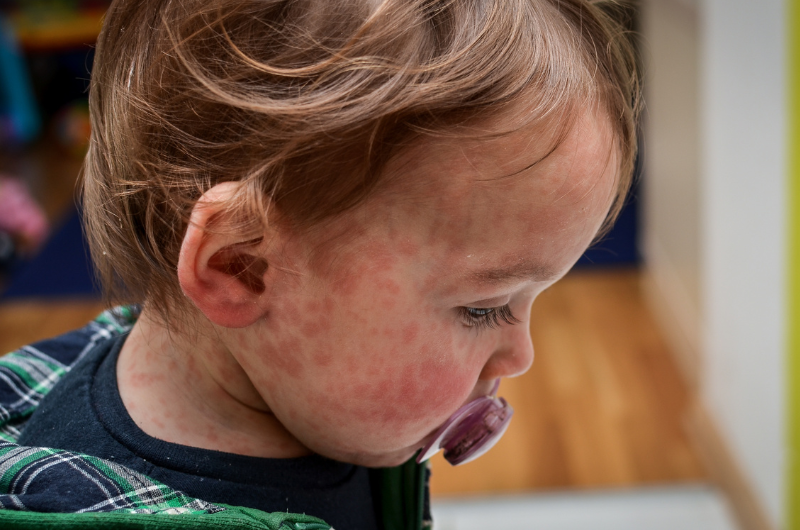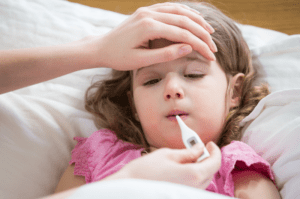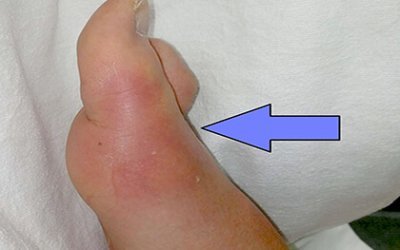Know the Common Skin Disorders in Children and Treatment

Children often experience a variety of skin disorders that can cause significant discomfort and concern for parents. These conditions can range from common rashes to more chronic issues like eczema. Understanding these disorders and knowing how to treat them naturally can greatly benefit your child’s skin health and overall well-being. This article delves into identifying common skin disorders in children and offers natural treatments using herbs and home remedies, avoiding synthetic drugs.
1. Common Skin Disorders in Children
1.1. Eczema (Atopic Dermatitis)
Eczema is a chronic condition characterized by dry, itchy, and inflamed skin. It often appears on the face, hands, and feet of young children.
- Symptoms: Dry, red patches; severe itching; thickened, scaly skin.
- Triggers: Allergens (e.g., pollen, dust mites), irritants (e.g., soaps, detergents), and stress.
1.2. Diaper Rash
Diaper rash is a common issue in infants, caused by prolonged exposure to a wet or dirty diaper.
- Symptoms: Red, inflamed skin in the diaper area; possible blistering or open sores.
- Causes: Prolonged moisture, friction, and exposure to urine or feces; yeast infections.
1.3. Impetigo
Impetigo is a highly contagious bacterial skin infection, often affecting preschool-aged children.
- Symptoms: Red sores, usually around the nose and mouth, that burst and form a yellow-brown crust.
- Causes: Bacterial infection, typically by Staphylococcus aureus or Streptococcus pyogenes.
1.4. Heat Rash (Miliaria)
Heat rash occurs when sweat ducts become blocked and swell, often in hot and humid weather.
- Symptoms: Small red bumps; itching or a prickly feeling; usually appears on the neck, chest, and skin folds.
- Causes: Excessive sweating, hot and humid weather, tight clothing.
1.5. Ringworm
Ringworm is a common fungal infection that presents as ring-shaped, red, scaly patches.
- Symptoms: Ring-shaped lesions with a raised, scaly border; itching.
- Causes: Fungal infection, typically transmitted through contact with infected individuals or animals.
2. Identifying Skin Disorders in Children
2.1. Symptoms to Watch For
- Redness and Irritation: Initial signs of many skin disorders.
- Itching and Discomfort: Common in conditions like eczema and heat rash.
- Swelling and Blisters: Seen in more severe reactions such as impetigo and diaper rash.
- Unusual Patches or Rashes: Indicative of infections like ringworm or eczema flare-ups.
2.2. When to Seek Professional Help
- Persistent or Worsening Symptoms: If symptoms do not improve with home care.
- Signs of Infection: Pus, fever, or spreading redness.
- Difficulty Managing Symptoms: When home remedies are not effective.
3. Natural Treatments for Children’s Skin Disorders
3.1. Herbal Remedies
Aloe Vera: Known for its soothing and anti-inflammatory properties.
- How to use: Apply fresh aloe vera gel directly to the affected area.
- Research Link: Aloe Vera and Its Effects on Skin Health
Calendula: This herb has healing properties that help soothe irritated skin.
- How to use: Apply calendula cream or ointment to the affected area.
- Research Link: Calendula for Skin Healing
Chamomile: Reduces inflammation and itching.
- How to use: Apply chamomile tea compresses to the skin.
- Research Link: Chamomile for Inflammation
3.2. Home Remedies
Oatmeal Baths: Relieve itching and inflammation.
- How to use: Add colloidal oatmeal to a lukewarm bath and soak for 15-20 minutes.
- Research Link: Oatmeal Baths for Skin Relief
Coconut Oil: Moisturizes and reduces inflammation.
- How to use: Apply virgin coconut oil to affected areas several times a day.
- Research Link: Coconut Oil for Skin Conditions
Honey: Has antibacterial and anti-inflammatory properties.
- How to use: Apply raw honey to affected areas and leave for 20 minutes before rinsing.
3.3. Dietary Adjustments
Anti-Inflammatory Foods: Include foods rich in omega-3 fatty acids, antioxidants, and vitamins.
- Examples: Salmon, leafy greens, berries, and nuts.
- Research Link: Diet and Skin Health
Avoid Trigger Foods: Identify and eliminate foods that may cause or worsen allergies.
- Common triggers: Dairy, gluten, and processed foods.
4. Lifestyle Changes to Manage Skin Disorders
4.1. Skincare Routine
- Gentle Cleansing: Use mild, fragrance-free cleansers.
- Regular Moisturizing: Apply natural moisturizers like shea butter or jojoba oil.
4.2. Environmental Control
- Keep Skin Dry: Ensure that areas prone to rash (like the diaper area) are kept clean and dry.
- Use Natural Fabrics: Dress children in breathable fabrics like cotton to reduce irritation.
4.3. Stress Management
- Create a Calming Environment: Ensure the child has a stress-free environment as stress can exacerbate skin conditions.
- Adequate Sleep: Ensure the child gets enough restful sleep to support overall health and skin repair.
5. Preventing Skin Disorders
5.1. Proper Hygiene
- Regular hand washing to prevent the spread of infections.
- Keeping nails trimmed to reduce scratching and further irritation.
5.2. Avoiding Irritants
- Use fragrance-free and hypoallergenic products.
- Avoid harsh soaps and detergents.
Conclusion: Embracing Natural Treatments for Children’s Skin Health
Identifying skin disorders and treating them with natural remedies can significantly improve a child’s skin health and quality of life. Embrace a holistic approach to skincare, incorporating herbal treatments and lifestyle changes for long-term relief.
References
- H.K.Bakhru (1992) Herbs That Heal: Natural Remedies for Good Health. Orient Paperbacks. Delhi, India.
- T.V.Sairam (1999) Home Remedies Vol-II: A Handbook of Herbal Cures for Common Ailments. Penguin Books India.
Dos
- Keep Skin Clean and Dry: Regularly cleanse your child’s skin with mild, fragrance-free soap and ensure it is thoroughly dried, especially in areas prone to moisture.
- Use Natural Fabrics: Dress your child in breathable fabrics like cotton to reduce skin irritation and prevent sweating.
- Apply Moisturizers: Use natural moisturizers such as coconut oil, shea butter, or aloe vera gel to keep the skin hydrated.
- Introduce Anti-Inflammatory Foods: Incorporate foods rich in omega-3 fatty acids, antioxidants, and vitamins, such as salmon, leafy greens, berries, and nuts.
- Opt for Herbal Remedies: Use proven herbs like calendula, chamomile, and turmeric for their soothing and anti-inflammatory properties.
- Patch Test New Products: Always do a patch test before applying any new product to your child’s skin to check for possible allergic reactions.
- Maintain a Cool Environment: Keep your child’s environment cool and comfortable to prevent heat rash and sweating.
- Ensure Adequate Hydration: Keep your child well-hydrated to support skin health.
- Regularly Trim Nails: Keep your child’s nails short to prevent skin damage from scratching.
Don’ts
- Avoid Harsh Soaps and Detergents: Steer clear of products that contain harsh chemicals, fragrances, or dyes that can irritate the skin.
- Do Not Over-Bathe: Avoid frequent bathing as it can strip the skin of natural oils, leading to dryness and irritation.
- Avoid Synthetic Fabrics: Stay away from synthetic fabrics like polyester that can trap heat and moisture, causing skin irritation.
- Don’t Use Steroid Creams Unnecessarily: Avoid using steroid creams without medical advice as they can have side effects, especially on young skin.
- Avoid Allergens and Irritants: Identify and eliminate allergens and irritants from your child’s environment, such as dust mites, pet dander, and certain foods.
- Do Not Scratch: Discourage your child from scratching the affected areas as it can lead to infections and worsen the condition.
- Avoid Tight Clothing: Do not dress your child in tight clothing that can cause friction and worsen skin conditions.
- Don’t Ignore Symptoms: If your child’s symptoms persist or worsen, seek medical advice rather than relying solely on home remedies.
- Avoid Overheating: Keep your child from overheating, which can exacerbate skin conditions like eczema and heat rash.
Send Us A Message
FAQs
The most common skin disorders in children include eczema (atopic dermatitis), diaper rash, impetigo, heat rash (miliaria), and ringworm. These conditions vary in symptoms and severity but are generally treatable with natural remedies and proper skincare.
Natural treatments for eczema include:
- Aloe Vera Gel: Soothes and moisturizes the skin.
- Coconut Oil: Reduces inflammation and hydrates the skin.
- Oatmeal Baths: Relieve itching and soften the skin.
- Chamomile Compresses: Reduce inflammation and irritation.
To prevent diaper rash:
- Change diapers frequently to keep the area dry and clean.
- Use gentle, fragrance-free wipes or water and a soft cloth.
- Allow diaper-free time to let the skin breathe.
- Apply a natural barrier ointment like zinc oxide or coconut oil.
Heat rash is caused by blocked sweat ducts, often due to hot and humid weather. Natural remedies include:
- Cool Baths: Bathe the child in cool water to reduce skin temperature.
- Loose Clothing: Dress the child in loose, breathable fabrics like cotton.
- Aloe Vera: Apply aloe vera gel to soothe the skin.














